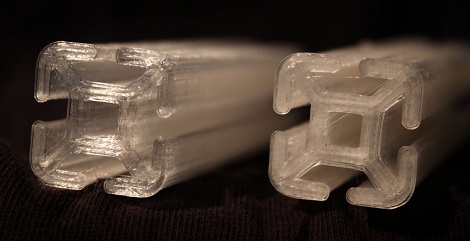
Those of us with 3D printers have had two major choices when selecting a material to print with – ABS, a very hard plastic, and PLA, a more brittle plastic with a lower melting point. [Alex] and [Luke] have been experimenting with printing polycarbonate and creating clear crystalline objects on a standard 3D printer.
The first foray into printing polycarbonate didn’t go so well for [Luke]. Objects came out looking very milky and there was a bit of popping during filament extrusion. The guys solved this problem by putting the polycarbonate filament in a food dehydrator overnight to get rid of the moisture. Polycarbonate has a higher melting temperature than other plastics – around 260 degrees Celsius – which can cause some problems with Teflon insulators in the hot ends of extruders. The guys didn’t have any problems with fumes, though.
If you’ve ever wanted to print something clear, it looks like it’s now possible. Check out the video after the break to see a Makerbot Thing-O-Matic printing with clear polycarbonate.
[youtube=http://www.youtube.com/watch?&v=AnmTjoua1gI&w=470]














I would not call ABS a “very hard plastic,” particularly when the alternative to compare it to is PLA!
PLA is hard and brittle, ABS is more malleable, and flexes rather than snap.
Other engineering plastics like PETG can be harder AND less brittle, or like doped PLA, and both soft and very flexible. (Both of these are way harder to extrude, as in a DIY 3D printer).
But in case I sounded negative on the article, I am far from it!
Polycarbonate is really cool, others in the reprap community have worked with it before: http://richrap.blogspot.com/2011/09/indestructamendel-polycarbonate-3d.html
And it makes AWESOME parts. It’s just much more difficult to use as compared with the more common blends of PLA and ABS.
“Those of us with 3D printers have had two major choices when selecting a material to print with – ABS, a very hard plastic, and PLA”
Speak for yourself.
Those of us with commercial SLA printers have a huge choice of options – epoxies, filled materials, high temperature, clear, ABS like, PP like, etc.
We can’t all be awesome.
Is there a clear ABS or PLA plastic? I keep seeing repraps assembled with clear looking parts.
That would be PLA.
http://reprap.org/wiki/PLA
ABS can also be had in a clear form.
Natural ABS is milky and Natural PLA is clear…ish. It’s slightly yellow and solid objects quickly lose clarity. For printing, more exciting than it being clear (I think it has some of the best optical clarity of anything anywhere if I’m not mistaken) is how strong it is and the higher temperatures it can withstand. It’s true though, big ol’ commercial machines have been printing Polycarbonate for awhile. We’re just now starting to see more materials successfully adapted to DIY and Hobby 3d Printers.
:) Those look like dozer sticks! Anybody else remember the fraggles? Nice job guys.
Heh…that’s an awesome association to have when seeing those.
Has anyone managed to print with spun sugar yet?
I can imagine making dozer-like castles with spun sugar dyed different colors!
Also, as a side note for the mods: why is the reply button hidden beneath the report button on the mobile site?
Arcol is making a V4 of his hot end that is 100% metal so should allow printing polycarbonate without problems. Printing polycarbonate with currently available hot ends will shorten the hot end life significantly so a full metal hot end is really required
which printer is best for producing small, clear,
polycarbonate items. I am a beginner